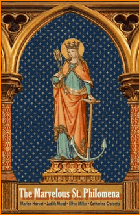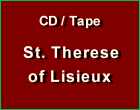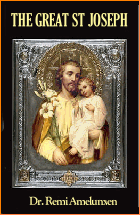Symbolism
 |
 |
 |
 |
 |
 |
 |
The Lily & Sword in the Last Judgment
Recently a reader sent a question to TIA asking about the symbolism surrounding Our Lord in the painting The Last Judgment by the Flemish painter Hans Memling (1435-1494), which you can see below. He asked: What is the deeper meaning behind these symbols and postures? I am answering this question here.
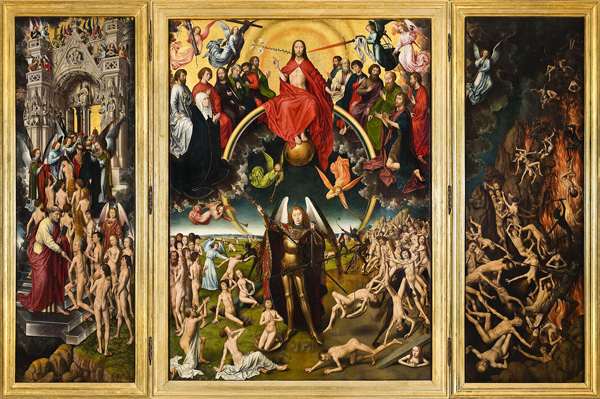 Our Lord is shown seated on an arch in the center of the canvas, and from His mouth a stalk with a lily floats to His right, and to His left a fiery sword. The reader noted that there are several different paintings with a similar depiction, such as the picture used as illustration in the article The Medicine of Mercy by Robert Banaugh posted on our website.
Our Lord is shown seated on an arch in the center of the canvas, and from His mouth a stalk with a lily floats to His right, and to His left a fiery sword. The reader noted that there are several different paintings with a similar depiction, such as the picture used as illustration in the article The Medicine of Mercy by Robert Banaugh posted on our website.
I am quite pleased to provide some information about the symbolism in the Last Judgment Triptych by Memling. It offers me the opportunity to explain the rich Catholic teaching that Medieval and Renaissance artists so masterfully embedded in their works.
Here, Memling depicts Christ in the Maiestas Domini (majesty of the Lord) seated on a golden bow representing the whole created universe; His feet rest on a globe representing the earth, man's part of all Creation.
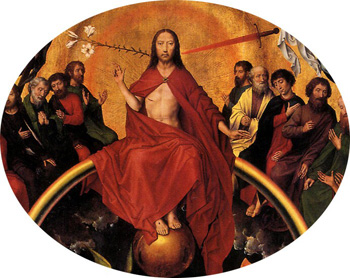 The bow also surrounds earth like a rainbow, the symbol of the covenant God made with Noah after the Deluge as a sign of His mercy after having manifested His justice.
The bow also surrounds earth like a rainbow, the symbol of the covenant God made with Noah after the Deluge as a sign of His mercy after having manifested His justice.
Christ seated on a bow signifies that God the Father fulfilled His covenant to redeem man by sending His Son Jesus Christ, who purchased redemption for man by His life, Crucifixion and Resurrection.
The Angels on either side of Christ carry the symbols of His Passion: the Cross, the pillar and scourge, the crown of thorns, the hammer and nails, the lance and vinegar-soaked sponge. With these instruments of the Passion, Christ made our redemption. Thus, the Angels carry them with an enormous respect. According to St. Louis Marie Grignion de Montfort, at the end of the world the Angels will keep these precious relics of the Passion, which will be the only things to survive the destruction of earth.
The lily and sword that emerge from the mouth of Christ can seem strange to our eyes. But the symbolism was well understood by Catholics of the 15th century.
Our Lord presides over the Last Judgment as the Supreme Judge. The lily to His right symbolizes His mercy and mirrors the palm-up blessing of His right hand. The sword to His left symbolizes His justice and is accompanied by the palm-down condemnation of His left hand. Thus, Our Lord represents the Judge who deals out the perfect justice and the perfect mercy.
The saved and the condemned
Between Heaven and Earth, Angels are blowing the trumpets announcing the Last Judgment. On the side of the lily and upraised palm of Christ, we find those who find mercy.
At the right of St. Michael, an Angel in blue and a black devil are still fighting over one soul, but the viewer feels certain of mercy's victory since the battle is taking place on the side of the saved. The triptych’s panel at Christ’s right shows the entrance of Heaven, reserved for the elect.
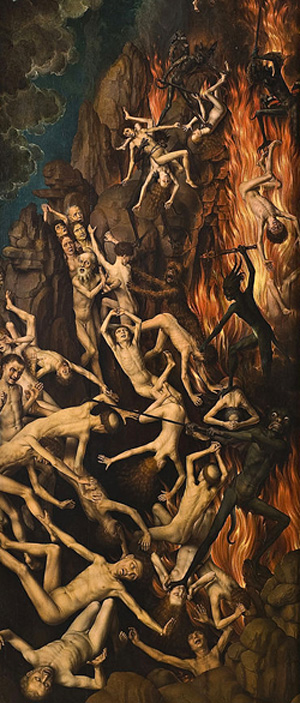 Beneath the sword and palm-down hand of Christ are the condemned who moan in despair at their sentence. Here justice prevails and all is barren and bleak. The brown bare earth on this side of the panel contrasts with the verdant green grass on the side of the saved. Every detail carries a meaning.
Beneath the sword and palm-down hand of Christ are the condemned who moan in despair at their sentence. Here justice prevails and all is barren and bleak. The brown bare earth on this side of the panel contrasts with the verdant green grass on the side of the saved. Every detail carries a meaning.
In the center of the judgment on earth stands the Archangel Michael in 15th-century armor. In his left hand he carries a balance scale, which tips in favor of the righteous side of the man knelt in prayer.
The scale was often used in medieval judgment scenes, referring to Daniel interpreting the writing on the wall at King Belshazzar's feast where he read, "You have been weighed in the balances and found wanting" (5:27). For the soul of the just man has more substance and weight than that of the unrighteous man. In the scale the good and bad side of a man are being judged.
In his right hand St. Michael carries a ferula surmounted by a jeweled cross.
At St. Michael's left, other damned souls thrash and groan as, mocked by devils, they realize their fate: the Hell depicted on the right panel. They are damned to hellfire, separated forever from the Way, the Truth and the Life that they rejected on earth.
Dante's description of Hell in The Divine Comedy influenced Memling, as it did for so many other artists for centuries, until the modern sentiment that such scenes might frighten children prevailed and these paintings were "hidden" in museums and private collections, away from the daily lives of the people.
This is in fact what happened to Memling's Last Judgment. Providence brought this grand triptych to Poland when the galleon on which it was being transported to Pisa was captured in 1473 in a sea battle. The captain landed the ship in Danzig and gave the triptych to St. Mary's Church. There it remained until its removal to the city museum after World War II.
The just souls, Our Lady & the Apostles
On the left panel, we find the just souls – led by a Pope, a Cardinal and a Bishop – who are greeted by St. Peter at Heaven's Gate. The Angels clothe them with celestial garments before they enter Heaven.
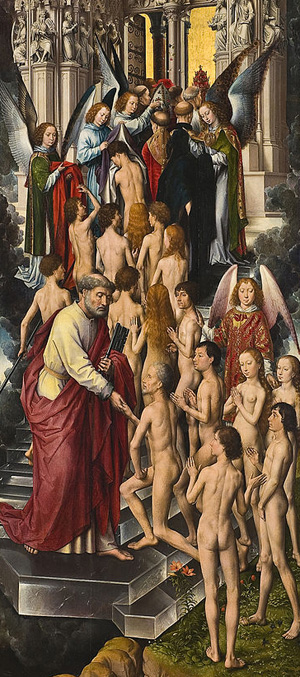 In Medieval art we often find naked men and women depicted in scenes of the Last Judgment. In a world still unmarked by the Freudian sexual revolution, such depictions had no immoral or pornographic connotations.
In Medieval art we often find naked men and women depicted in scenes of the Last Judgment. In a world still unmarked by the Freudian sexual revolution, such depictions had no immoral or pornographic connotations.
The medieval man knew that he was as naked in death as at birth, that he appears before God at Judgment without any rich apparel or possessions to speak in his favor, as wealth often does at earthly courts. In death, only faith and good works count and, of course, devotion to the great Mediatrix Our Lady.
Our gaze turns upward again and, there in the central panel, we find the Mother of Our Lord kneeling in prayer at His right side. She is in Flemish costume, following the medieval trend to dress the Saints in regional apparel. Also surrounding Christ on both sides are the 12 Apostles and a kneeling St. John the Baptist, who intercede for the human souls.
Even without their emblems, the Apostles would have been recognized by the medievals: the beardless brown-haired apostle John at the side of Our Lady, the also beardless doubting Thomas making his profession of faith with hand over his heart; St. Paul with red hair and beard placed prominently next to St. John the Baptist; St. Simon with his high forehead and balding grey hair and beard as compared to the contemplative St. Matthew with a full head of white hair and beard, and so on.
The Apostles and Saints were as familiar to the faithful of this blessed time as their relatives. In medieval Christendom man had an intimacy with Heaven that has sadly been lost with the so-called progress of the modern world.
As we see plainly, the triptych was more than a simple artistic masterpiece; it was also a magnum opus in pedagogy, instructing the people in the truths of the Faith. Right and wrong are black and white in the Middle Ages: The good receive the eternal reward, the evil are condemned to Hell.
What we find in Memling's Last Judgment is Faith depicted in art. Today, unfortunately, the symbolism in the painting is barely understood because the Faith has been set aside or, worse yet, distorted. Mercy, justice and truth have been blurred by relativism and perverted by the New Theology that has openly reigned since Vatican II.
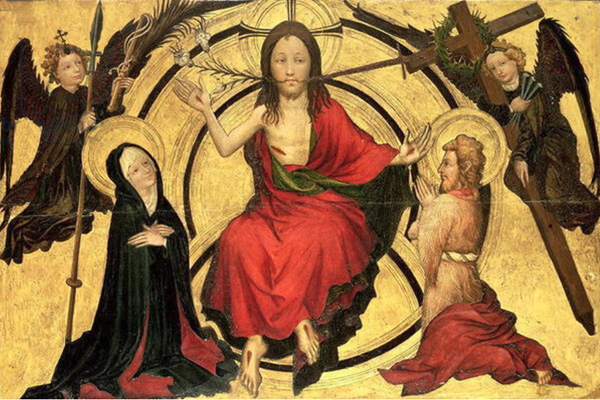


The Last Judgment Triptych, Hans Memling - for a larger picture click here
I am quite pleased to provide some information about the symbolism in the Last Judgment Triptych by Memling. It offers me the opportunity to explain the rich Catholic teaching that Medieval and Renaissance artists so masterfully embedded in their works.
Here, Memling depicts Christ in the Maiestas Domini (majesty of the Lord) seated on a golden bow representing the whole created universe; His feet rest on a globe representing the earth, man's part of all Creation.

Christ seated on a bow signifies that God the Father fulfilled His covenant to redeem man by sending His Son Jesus Christ, who purchased redemption for man by His life, Crucifixion and Resurrection.
The Angels on either side of Christ carry the symbols of His Passion: the Cross, the pillar and scourge, the crown of thorns, the hammer and nails, the lance and vinegar-soaked sponge. With these instruments of the Passion, Christ made our redemption. Thus, the Angels carry them with an enormous respect. According to St. Louis Marie Grignion de Montfort, at the end of the world the Angels will keep these precious relics of the Passion, which will be the only things to survive the destruction of earth.
The lily and sword that emerge from the mouth of Christ can seem strange to our eyes. But the symbolism was well understood by Catholics of the 15th century.
Our Lord presides over the Last Judgment as the Supreme Judge. The lily to His right symbolizes His mercy and mirrors the palm-up blessing of His right hand. The sword to His left symbolizes His justice and is accompanied by the palm-down condemnation of His left hand. Thus, Our Lord represents the Judge who deals out the perfect justice and the perfect mercy.
The saved and the condemned
Between Heaven and Earth, Angels are blowing the trumpets announcing the Last Judgment. On the side of the lily and upraised palm of Christ, we find those who find mercy.
At the right of St. Michael, an Angel in blue and a black devil are still fighting over one soul, but the viewer feels certain of mercy's victory since the battle is taking place on the side of the saved. The triptych’s panel at Christ’s right shows the entrance of Heaven, reserved for the elect.

The Hell panel in Memling's Last Judgment
In the center of the judgment on earth stands the Archangel Michael in 15th-century armor. In his left hand he carries a balance scale, which tips in favor of the righteous side of the man knelt in prayer.
The scale was often used in medieval judgment scenes, referring to Daniel interpreting the writing on the wall at King Belshazzar's feast where he read, "You have been weighed in the balances and found wanting" (5:27). For the soul of the just man has more substance and weight than that of the unrighteous man. In the scale the good and bad side of a man are being judged.
In his right hand St. Michael carries a ferula surmounted by a jeweled cross.
At St. Michael's left, other damned souls thrash and groan as, mocked by devils, they realize their fate: the Hell depicted on the right panel. They are damned to hellfire, separated forever from the Way, the Truth and the Life that they rejected on earth.
Dante's description of Hell in The Divine Comedy influenced Memling, as it did for so many other artists for centuries, until the modern sentiment that such scenes might frighten children prevailed and these paintings were "hidden" in museums and private collections, away from the daily lives of the people.
This is in fact what happened to Memling's Last Judgment. Providence brought this grand triptych to Poland when the galleon on which it was being transported to Pisa was captured in 1473 in a sea battle. The captain landed the ship in Danzig and gave the triptych to St. Mary's Church. There it remained until its removal to the city museum after World War II.
The just souls, Our Lady & the Apostles
On the left panel, we find the just souls – led by a Pope, a Cardinal and a Bishop – who are greeted by St. Peter at Heaven's Gate. The Angels clothe them with celestial garments before they enter Heaven.

The just greeted by St. Peter at Heaven's gates
The medieval man knew that he was as naked in death as at birth, that he appears before God at Judgment without any rich apparel or possessions to speak in his favor, as wealth often does at earthly courts. In death, only faith and good works count and, of course, devotion to the great Mediatrix Our Lady.
Our gaze turns upward again and, there in the central panel, we find the Mother of Our Lord kneeling in prayer at His right side. She is in Flemish costume, following the medieval trend to dress the Saints in regional apparel. Also surrounding Christ on both sides are the 12 Apostles and a kneeling St. John the Baptist, who intercede for the human souls.
Even without their emblems, the Apostles would have been recognized by the medievals: the beardless brown-haired apostle John at the side of Our Lady, the also beardless doubting Thomas making his profession of faith with hand over his heart; St. Paul with red hair and beard placed prominently next to St. John the Baptist; St. Simon with his high forehead and balding grey hair and beard as compared to the contemplative St. Matthew with a full head of white hair and beard, and so on.
The Apostles and Saints were as familiar to the faithful of this blessed time as their relatives. In medieval Christendom man had an intimacy with Heaven that has sadly been lost with the so-called progress of the modern world.
As we see plainly, the triptych was more than a simple artistic masterpiece; it was also a magnum opus in pedagogy, instructing the people in the truths of the Faith. Right and wrong are black and white in the Middle Ages: The good receive the eternal reward, the evil are condemned to Hell.
What we find in Memling's Last Judgment is Faith depicted in art. Today, unfortunately, the symbolism in the painting is barely understood because the Faith has been set aside or, worse yet, distorted. Mercy, justice and truth have been blurred by relativism and perverted by the New Theology that has openly reigned since Vatican II.

Another 15th century Last Judgment with the lily and sword, German school

Posted January 27, 2016
______________________
______________________




